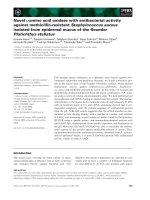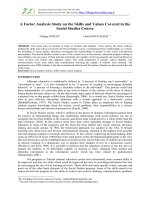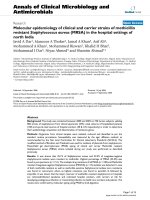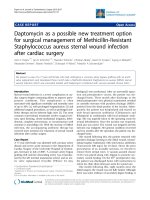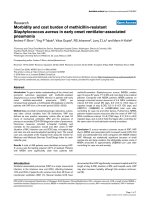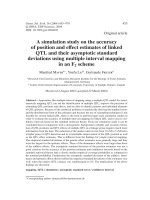A prospective study on the prevalence and antibiotic sensitivity pattern of methicillin resistant staphylococcus aureus isolated from various clinical specimen at a tertiary care post
Bạn đang xem bản rút gọn của tài liệu. Xem và tải ngay bản đầy đủ của tài liệu tại đây (305.94 KB, 11 trang )
Int.J.Curr.Microbiol.App.Sci (2017) 6(3): 1859-1869
International Journal of Current Microbiology and Applied Sciences
ISSN: 2319-7706 Volume 6 Number 3 (2017) pp. 1859-1869
Journal homepage:
Original Research Article
/>
A Prospective Study on the Prevalence and Antibiotic Sensitivity Pattern of
Methicillin Resistant Staphylococcus aureus isolated from Various Clinical
Specimen at a Tertiary Care Post Graduate Teaching Institute
Anjali Kulshrestha1*, V. Anamika2, K. Mrithunjay2, V. Himanshu3,
K. Manish4 and A.S Dalal2
1
Department of Microbiology, NIMS, Shobha nagar, Jaipur, Rajasthan, India
2
Department of Microbiology, GMCH, Udaipur, India
3
Departmen of Anaesthesia and Critical Care, SRMS-IMS, Bareilly, India
4
DNB, Apollo, New Delhi, India
*Corresponding author:
ABSTRACT
Keywords
MSSA, MRSA,
Multidrug
resistance.
Article Info
Accepted:
24 February 2017
Available Online:
10 March 2017
In recent times, the treatment of Staphylococcus aureus infection has become problematic
because of emergence of resistance to antibiotics which is a cause of concern for all the
clinicians and microbiologists worldwide. Infections caused by MRSA have been
associated with high morbidity and mortality rates. Hence this study was conducted to
know the prevalence of Methicillin resistant Staphylococcus aureus [MRSA] isolates in
various clinical specimens and to determine the sensitivity of these isolates to different
antimicrobial agents. Among the 161 clinical isolates of S. aureus, highest isolation was
from pus samples (64%), followed by blood (13%) and respiratory secretions (13%). 82
(51%) were identified as MRSA by Cefoxitin disc diffusion method and maximum MRSA
were again isolated from pus (61%). Comparatively MRSA prevalence is more in males
(73%) and most common affected age group was 21-30 years. All MRSA strains were
resistant to penicillin (100%), followed by ciprofloxacin (93%) and erythromycin (61%).
We found statistically significant differences in the drug susceptibility pattern of MRSA &
MSSA for Penicillin, Clindamycin, Erythromycin, Ciprofloxacin, Co-trimoxazole and
Levofloxacin. MDR-MRSA strains in our study is 45%. Hence we suggest, more and more
studies in future are needed to fight against rising menace of antibiotic resistance among
Staphylococcus aureus
Introduction
Staphylococcus aureus, the most clinically
significant species of Staphylococci has been
recognized as an important cause of human
disease for more than 100 years (Ankur et al.,
2013). It is one of the pathogens of greatest
concern because of its intrinsic virulence
factors, its ability to cause diverse array of life
threatening infections, it’s competency to
adapt to different environmental conditions
and its nasal carriage, which accounts for
possible spread and re infection (Anupurba et
al., 2003). Infections by Staphylococcus
aureus are continuously challenging the
clinicians despite the availability of
antibiotics from nearly 70 yrs. This was due
to the emergence of various types of antibiotic
1859
Int.J.Curr.Microbiol.App.Sci (2017) 6(3): 1859-1869
resistance
mechanisms
especially
to
methicillin and vancomycin, which was the
theme of several epidemiological studies
(Arora et al., 2010; Assadullah et al., 2003).
With the introduction of Penicillin in 1940, it
was thought that we can escape from the
deadly threats of Staphylococcal infections,
but no sooner in 1944 first strain of
Staphylococcus aureus resistant to penicillin
G appeared in London, mediated by the
presence of penicillinase enzyme which
hydrolyses the β-lactam ring of penicillin
(Astagneau et al., 1996). By 1950s,
penicillinase
producing
strains
of
Staphylococcus aureus were so common that
penicillin
became
useless
against
Staphylococcal infections. To resolve this
issue, in 1960 semi-synthetic penicillin
(penicillinase stable penicillin) - like
Methicillin came in picture, but availability of
these agents did not stem the tide of resistance
as within a year the first MRSA was reported
from U.K. This was mediated by the presence
of PBP-2a which is expressed by an
exogenous gene, mecA (Bandaru, 2010).
In the past few decades MRSA has emerged
as an important nosocomial pathogen
worldwide. In India, prevalence rate varies
from 30-85% in different parts and has now
become endemic (Barber, 1961; Boucher,
2010). A multicentric study done in India
involving 17 tertiary care Hospitals reported
MRSA prevalence of 41% in 2008-2009
(Clinical and Laboratory Standards Institute,
2012), MRSA is of serious therapeutic
concern not only due to its resistance to
Methicillin, but also because of resistance to
many other antimicrobials that are used on
regular basis in Hospitals. Therefore, the most
reliable and sustained therapeutic agent
against methicillin-resistant Staphylococcus
aureus (MRSA) strains is Vancomycin.
Increasing prevalence of MRSA has lead to
the extensive use of vancomycin. This inturn
has lead to the decreased susceptibility to
vancomycin. Such resistance is a serious
clinical and public health consequences
because currently few licenced alternatives
are available to treat vancomycin resistant
Staphylococcus aureus infections.
The association of Multidrug resistance with
MRSA adds to the problem and the presence
of MDR strains in the hospital cannot be
neglected. Several studies are prevailing for
Methicillin resistance from India but few have
worked on Multi-drug resistance. MRSA
strain showing resistance towards ≥ 3
antibiotics is defined as MDR strain and its
prevalence ranges from 23% - 60% in India
(Diep et al.,). The emergence of MDR MRSA
infections is worrisome in the present
therapeutic scenario. Keeping the above
points in view, the present study was planned
to find out the prevalence of MRSA among
isolates of Staphylococcus aureus in various
clinical specimens along with their antibiotic
sensitivity pattern so as to guide the clinicians
of our hospital to select appropriate
antimicrobial agents and also to make them
aware, that if inappropriate use these
antibiotics is continued it may lead to
impending public health disaster.
Materials and Methods
Source of material
The present study was conducted in the
Department of Microbiology, GMCH,
Udaipur, during the year 2013-2014. A total
of 161 non- duplicate Staphylococcus aureus
isolates from various clinical specimens [pus,
wound or vaginal swabs, blood, body fluids
(csf, pleural fluid, ascitic fluid) urine, sputum,
ET secretion etc] were included in the study.
Isolates from both in-patients and out-patients
were considered. Institutional Ethical
clearance was obtained. Data regarding age,
sex, patient location, history of any clinical
1860
Int.J.Curr.Microbiol.App.Sci (2017) 6(3): 1859-1869
All Staphylococcus aureus strains isolated
from various clinical specimens, were
included in the study.
Erythromycin [15μg], Clindamycin [2μg],
Rifampicin
[5μg]
and
Cotrimoxazole
[1.5/23.75µg]. Staphylococcus aureus ATCC
25923 was used as control strain. Zone of
inhibition of all the antibiotics were measured
with scale in reflected light against a black
background, to the nearest mm. Interpretation
was done according to the guidelines of
Clinical Laboratory Standards Institute.
Exclusion criteria
Detection of methicillin resistance
Clinical specimen’s yielding growth of Gram
positive cocci other than Staphylococcus
aureus and all gram negative bacteria were
excluded.
Cefoxitin disc (30 µgm) was used to detect
methicillin resistant isolates as Cefoxitin,
which is a potent inducer of the mecA
regulatory system, is being widely used as a
surrogate marker for detection of mecA genemediated methicillin resistance. MRSA
strains exhibiting inducible resistance to
methicillin grow much more readily in the
presence of cefoxitin than oxacillin, due to an
enhanced induction of PBP 2a by cefoxitin.
Isolates with zone diameter of ≤21 mm were
considered resistant to methicillin and zone of
≥22 mm were sensitive (Harcharan et al.,
2014).
illness etc. was obtained from the requisition
form submitted to Microbiology Department,
GMCH.
Inclusion criteria
Isolation
and
identification
Staphylococcus aureus
of
All the isolates were identified by standard
procedures (gram staining, catalase test,
mannitol fermentation, Hugh-Leifson OF
media, slide coagulase and tube coagulase
test). Tube coagulase was taken as the main
criteria of identification and was performed
by diluting plasma in freshly prepared normal
saline (1:6). Three to four colonies were
emulsified in 1 ml of diluted plasma and the
tubes were incubated at 37ºC. Readings were
taken at 1, 2, 3 and 4 h and further incubated
at room temperature if no clot formation was
observed (Yogesh et al., 2013).
Determination of antibiotic susceptibility
All Staphylococcus aureus isolates were then
subjected to antimicrobial susceptibility
testing by modified Kirby–Bauer disc
diffusion method. Antibiotics tested were
Penicillin [10 units], cefoxitin (30 µg),
Vancomycin [30μg], Linezolid [30μg],
Pristinomycin
(Quinupristin/Dalfopristin)
[15μg], Gentamicin [10μg], Tetracycline
[30μg],
Chloramphenicol
[30
μg],
Ciprofloxacin [5μg], Levofloxacin [5μg],
Results and Discussion
In the present study, a total of 161 non
duplicate Staphylococcus aureus isolates were
obtained from various clinical specimens.
Staphylococcus aureus infection was found
comparatively more in Male patients i.e. 115
[71%] than in female patients 46 [29%]. The
male to female ratio was 2.5:1. Age group of
21-30 yrs and 51-60 yrs were predominantly
affected. [Figure 1 and figure 2]. Among all
Staphylococcus aureus isolates, majority
contribution was from Pus samples 103
(64%), followed with blood 23(15%),
respiratory secretion 18 (11%) and body
fluids 7 (4%). Swabs and Urine samples grew
only 7 (4%) and 3 (2%) respectively.[Table1]
Out of total 161 Staphylococcus aureus
strains, 82 (51%) were found to be MRSA
1861
Int.J.Curr.Microbiol.App.Sci (2017) 6(3): 1859-1869
and79 (49%) were MSSA. Pus shown the
highest prevalence of resistance towards
methicillin i.e. (61%) followed by Blood
(15%), Respiratory secretions (10%), body
fluids (5%), Swabs (5%), and Urine (4%).[
Figure 3, Figure 4 ] Comparatively MRSA
prevalence is more in males (73%) and most
common affected age group was 21-30 years.
Out of 161 Staphylococcus aureus, only 19
(12%) strains were sensitive to all
antibiotics.[Table 2] Maximum resistance was
shown by MRSA isolates. All the MRSA
isolates were resistant to penicillin (100%)
and all were sensitive to Linezolid,
Pristinomycin,
Chloramphenicol
and
Rifampicin. Among the MRSA strains, least
sensitivity was showed by Ciprofloxacin
(93%) followed by erythromycin (66%), Cotrimaxazole (54%), Levofloxacin (46%),
Clindamycin (46%) and Gentamicin (30%).
Tetracycline (6%), Vancomycin (3%) showed
good efficacy.
Table.1 Distribution pattern of Staphylococcus aureus isolates in various clinical specimens
Clinical specimen
Pus
Blood
Sputum/ ETsecretion / Bronchial aspirate
Body fluids (csf, pleural fluid, ascitic fluid)
Swabs ( Vaginal/wound)
Urine
Total
No of isolates
103
23
18
7
7
3
161
Percentage
64
15
11
4
4
2
100
Table.2 Antibiogram of Staphylococcus aureus strains
Drugs
Penicillin G
Cefoxitin
Ciprofloxacin
Levofloxacin
Gentamycin
Erythromycin
Clindamycin
Co-trimaxazole
Tetracycine
Rifampicin
Chloramphenicol
Vancomycin*
Linezolid
Quinipristin/dalphopristin
Staphylococcus aureus strains
Sensitive %
Resistant %
19
12
142
88
79
49
82
51
54
34
107
66
116
72
45
28
136
84
25
16
91
57
70
43
111
69
50
31
91
57
70
43
156
97
5
3
161
100
0
0
161
100
0
0
156
97
5
3
161
100
0
0
161
100
0
0
Vancomycin* - According to CLSI guidelines 2007[66]
1862
Int.J.Curr.Microbiol.App.Sci (2017) 6(3): 1859-1869
Table.3 Antibiogram of MRSA and MSSA
Drugs
Penicillin G
Ciprofloxacin
Levofloxacin
Gentamycin
Erythromycin
Clindamycin
Co-trimaxazole
Tetracycine
Rifampicin
Chloramphenicol
Vancomycin*
Linezolid
Quinipristin/dalphopristin
MRSA [n=82]
Sensitive
Resistance
(%)
(%)
0 (0)
82 (100)
6 (7)
76 (93)
44 (54)
38 (46)
57 (70)
25 (30)
28 (34)
54 (66)
44 (54)
38 (46)
38(46)
44(54)
77 (94)
5 (6)
82 (100)
0 (0)
82 (100)
0 (0)
82 (100)
5(3)
82 (100)
0 (0)
82 (100)
0 (0)
MSSA [n=79]
Sensitive
Resistance
(%)
(%)
19 (24)
60 (76)
48 (61)
31 (39)
72 (91)
7 (9)
79(100)
0 (0)
63 (80)
16 (20)
67 (85)
12 (15)
53(67)
26(33)
79 (100)
0 (0)
79 (100)
0 (0)
79 (100)
0 (0)
79 (100)
0 (0)
79 (100)
0 (0)
79(100)
0 (0)
Vancomycin* - According to CLSI guidelines 2007[66]
Table.4 Statistical analysis of antibiotic resistance pattern of MRSA and MSSA by using
software SPSS
Drugs
Penicillin G
Ciprofloxacin
Levofloxacin
Erythromycin
Clindamycin
Co-trimoxazole
MRSA
Resistance
(%)
82 (100)
76 (93)
42 (51)
50 (61)
38 (46)
44(54)
MSSA
Resistance
(%)
60 (76)
31 (39)
15 (19)
20 (25)
10 (13)
26(33)
p value
Statistical
Significance
<0.001
<0.001
<0.001
<0.001
<0.001
<0.001
Significant
Significant
Significant
Significant
Significant
Significant
Figure.1 Sex wise distribution of patients with Staphylococcus aureus infection
1863
Int.J.Curr.Microbiol.App.Sci (2017) 6(3): 1859-1869
Figure.2 Age wise distribution of patients with Staphylococcus aureus infection
Figure.3 Total number of MRSA and MSSA in Staphylococcus aureus isolates
Figure.4 Specimen wise distribution of MSSA
1864
Int.J.Curr.Microbiol.App.Sci (2017) 6(3): 1859-1869
The sensitivity pattern of MSSA was quite
different from the MRSA strains. All the
MSSA strains showed cent percent sensitivity
to Gentamicin, Tetracycline, Vancomycin,
Linezolid, Pristinomycin, Chloramphenicol
and Rifampicin. Levofloxacin showed the
highest sensitivity (91%) among MSSA
strains followed by Clindamycin (85%),
Erythromycin (80%), Co-trimoxazole (67%),
Ciprofloxacin (61%) and showed least
sensitivity to penicillin (24%).(Table 3)
Among all above mentioned drugs, antibiotic
resistance for MRSA and MSSA was
statistically significant only for Pencillin,
Clindamycin, Erythromycin, Ciprofloxacin,
Co-trimozole and Levofloxacin.(Table 4).
Staphylococcus aureus is a major human
pathogen and is one of the commonest
causative agent of Community and Hospital
acquired infections. The treatment of
Staphylococcus aureus infection has become
problematic because of emergence of
resistance
to
Penicillin,
Methicillin,
Vancomycin and many other antibiotics, by
acquiring several resistance mechanisms.
Increased antimicrobial resistance for such an
organism is, therefore a cause of concern.
In the past few decades MRSA has emerged
as an important nosocomial pathogen
worldwide. In India, prevalence rate varies
from 30-85% in different parts and has now
become endemic (Lowy, 1998). A
multicentric study done in India involving 17
tertiary care Hospitals reported MRSA
prevalence of 41% in 2008-2009 (Mallick et
al., 2010). MRSA is of serious therapeutic
concern not only due to its resistance to
Methicillin, but also because of resistance to
many other antimicrobials that are used on
regular basis in Hospitals. Therefore, the most
reliable and sustained therapeutic agent
against methicillin-resistant Staphylococcus
aureus (MRSA) strains is Vancomycin.
Extensive use of this antibiotic inturn lead to
the emergence of Vancomycin intermediate
Staphylococcus
aureus
[VISA]
and
Vancomycin resistant Staphylococcus aureus
[VRSA] strains in various parts of the world
(Manu et al., 2013).
In the present study a total of 161 nonduplicate Staphylococcus aureus strains were
isolated from various clinical specimens.
Among all these samples highest isolation
was from pus 103 (64%). Harcharan singh et
al., (2014) in Udaipur (65%), Manu
Chaudhary et al., (2013) in H.P (63%) and
Ankur Goyal et al., in Agra (66.03%), also
reported
the
highest
isolation
of
Staphylococcus aureus from pus.
All the Staphylococcus aureus strains were
screened for Methicillin resistance using
Cefoxitin disc diffusion method. Since it is a
potent inducer of mecA gene, hence
considered as a surrogate marker for detection
of methicillin resistance by CLSI 2012, in our
study 82 (51%) isolates turned out to be
MRSA and 79(49%) as MSSA, from a total of
161 Staphylococcus aureus strains. The
prevalence rate of MRSA in our institute is
51%, which is similar to the studies
conducted by Vidhani and Mehndiratta et al.,
in 2001 showing a prevalence rate of 51.6%
and almost comparable to the study conducted
by Majumdar et al., in 2001 and Assadullah et
al., in 2003 showing 52.9% prevalence rate.
The higher rate in their studies may been
attributed to the fact that the studies were
conducted at a tertiary care multispecialty
center with more and more patients coming
from pheriphery and small nursing homes,
where injudious use of antibiotics and
inadequate infection control policies are
prevalent. Verma et al., in 2000 reported a
higher prevalence rate of 80.89% in Indore
and Mehta et al., in 2007 reported a lower
prevalence rate of 24% in Chandhigarh. This
variation in prevalence may be because of
several factors like different Geographical and
1865
Int.J.Curr.Microbiol.App.Sci (2017) 6(3): 1859-1869
environmental conditions, population group
under study, healthcare facilities available in
the particular hospital, implementation and
monitoring of infection control committee,
rationale antibiotic usage which varies from
hospital to hospital. We have 51% prevalence
rate of MRSA in our hospital setup. It
therefore calls in for better vigilance and
implementation of more effective MRSA
surveillance programme complemented with
improved infection control practices.
In the present study, maximum MRSA were
isolated from pus 50 (61%), followed by
blood 13(15%), respiratory secretions 8
(10%), Swabs and body fluids 4(5%) each
and least from Urine 3(4%). This pattern
correlates with studies conducted by Vidya
Pai et al., in 2010 and Nitish Kumar Sharma
et al., 2013. This is due to the reason that
Staphylococcus aureus accounts for most of
the skin and soft tissue infections, septicemia
and also respiratory tract infection.
Comparatively MRSA prevalence was more
in males (73%) than in females (23%) in our
study. Similar findings was also reported by
Rao et al., (2010) and Abhishek Mewar et al.,
The increased rate of MRSA infections
among males could be due to their more
outdoor activities, inturn exposing them to
contaminated environment and also compared
to females, accidental injuries are more
common among men.
Most of the MRSA strains were isolated from
21-30 yrs of age group (ie 32%) and in 5160yrs (ie 26%), indicating MRSA infection is
more common in working and old age group.
The reason for this may be that younger age
group are more involved in outdoor activities
inturn exposing them to contaminated
environment and in older age group it may be
due to waning immunity, hormonal
abnormalities and co-morbid conditions.
Similar pattern of affected age group was also
reported by Ankur Goyal et al., in 2013.
Isolation was more from the IPD patients
(88.8%) than from the OPD patients (11.2%).
Among IPD patients, highest prevalence was
seen in orthopedics, oncology and surgical
wards. Similarly Mallick and Basak reported
84.8% MRSA from IPD patients, in which
maximum strains were isolated from surgical
and orthopedics ward. This might be because
the patients in these wards are usually with
open wounds and are debilitated. They
undergo multiple interventions in the hospital
which further increases the risk of MRSA
infection due to multiple people involvement
as well as prolonged stay in the wards. Along
with these factors, the patient is usually on
multiple antibiotics.
Resistance of MRSA to a wide range of
antibiotics is well documented35. In the
present study antibiotic resistance is
significantly more in MRSA strains of
Staphylococcus aureus as compared to MSSA
strains. Statistically significant difference was
observed for Penicillin, Fluoroquinolones,
Erthromycin,
Clindamycin
and
Cotrimoxazole. Such similar statistically
significant difference between the sensitivity
pattern of MRSA and MSSA was also
reported by Vidhani et al., (2013), Shilpa
Arora et al., (2013) Majumder et al., (2013).
For Penicillin 100% resistance was observed
for MRSA strains in our study and such
similar finding was also reported by Gupta et
al., (2010), Anupurba et al., The resistance
rate of Ciprofloxacin in MRSA strains was
high [93%], consistent with the resistance rate
of Pulimood et al., [90%] and Udaya Shankar
et al., [95.8%]. Our study had also showed
high degree of resistance to Erythromycin and
Co-trimoxazole. Such high resistance pattern
observed for these antibiotics in our study
may be due to the differential clonal
expansion and indiscriminate empirical use of
these drugs. The present study also showed a
low level of resistance to Clindamycin,
similar to the study conducted by Ankur
1866
Int.J.Curr.Microbiol.App.Sci (2017) 6(3): 1859-1869
Goyal et al., (2013). This may be due to the
antibiotic recycling and the dependence of the
clinicians more on beta lactam drugs. In the
light of the present study, we would
recommend use of Clindamycin for the
management of soft tissue infections, with
MRSA strains that are sensitive to
Clindamycin since it has better soft tissue
penetration and no renal dosing adjustments
and thus by reserving Vancomycin for life
threatening infections.
The association of Multidrug resistance with
MRSA adds to the problem and the presence
of MDR strains in the Hospital can’t be
neglected. Several studies are prevailing for
Methicillin resistance from India but few have
worked on Multi-drug resistance. MRSA
strain showing resistance towards ≥ 3
antibiotics is defined as MDR strain. MDR
MRSA strains in our study is 45%, a study
conducted by Majumder et al., (2013)
reported 23.2% MDR- MRSA, 32% by
Anupurva et al., and as high as 63.6% by
Rajaduraipandi et al., (2000). The emergence
of MDR MRSA infections is worrisome in the
present therapeutic scenario, hence a
continuous antibiotic surveillance is required
for all the Staphylococcus aureus isolates.
This inturn will help in formulation of
effective antibiotic policies in the health care
set-up or else the threat will increase.
In the present study 3% resistance was
observed for Vancomycin by disc diffusion
test, Harcharan Singh et al., (2013) conducted
a study in Udaipur and observed a higher
resistance of 13% to Vancomycin by using
Disc diffusion method only. Similarly Yogesh
Kumar Gupta et al., and Ankur Goyal et al.,
had reported no vancomycin resistance by
Disc diffusion in Rajasthan and Agra
respectively.
To conclude, the result of our present study
indicated high antibiotic resistance to
commonly used antibiotics by MRSA
isolates. The increase in vancomycin
resistance among MRSA and MDR‑ MRSA
and excessive use of antimicrobial agents has
worsened the sensitivity. Hence prudent and
responsible usage of newer antibiotics is
advocated to preserve their continued
effectiveness in the management of difficult
to treat infections caused by MRSA and
VRSA. We should undertake more and more
such studies in future to fight against rising
menace of antibiotic resistance. Also more
research should be done to find better
treatment policies, effective and cheaper
alternative antibiotics in developing countries
like ours. The findings of the studies should
be shared with hospital infection control
committee to help in the formulation of
infection control polices and also antibiotic
policies. So that the primary care givers can
use antibiotics rationally.
References
Ankur Goyal, Manish Kumar Diwakar, Suneel
Bhooshan, Sapna Goyal, Arti Agrawal. et
al. 2013. Prevalence and Antimicrobial
Susceptibility Pattern of Methicillinresistant Staphylococcus aureus [MRSA]
isolates at a Tertiary Care Hospital in Agra,
North India – A systemic annual review. J.
Dent. Med. Sci. (IOSR-JDMS), 11(6): 8084.
Anupurba, S., Sen, M.R., Nath, G., Sharma,
B.M., Gulati, A.K., Mohapatra, T.M. 2003.
Prevalence
of
methicillin
resistant
Staphylococcus aureus in tertiary referral
hospital in Eastern Uttar Pradesh. Indian J.
Med. Microbiol., 21(1): 49-51.
Arora, S., Devi, P., Arora, U., Devi, B. 2010.
Prevalence of Methicillin- resistant
Staphylococcus aureus (MRSA) in a
tertiary care hospital in northern India. J.
Lab Physicians, 2: 78-81.
Assadullah, S., Kakru, D.K., Thoker, M.A.,
Bhat, F.A., Hussain, N., Shah, A. et al.
2003. Emergence of low level vancomycin
1867
Int.J.Curr.Microbiol.App.Sci (2017) 6(3): 1859-1869
resistance in MRSA. Indian J. Med.
Microbiol., 21: 196–198.
Astagneau, P., and The French Prevalance
Survey Study Group, 2000. Prevalence of
nosocomial infection in France: results of
nationwide survey in 1996. J. Hosp. Infect.,
46:186-193
Baird. 1996. Staphylococcus: Cluster-forming
gram-positive cocci. In: Collee JG, Fraser
AG, Marmion BP, Simmons A, editors.
Mackie and McCartney Practical Medical
microbiology.
14th
edn.
Edinburg:
Churchill Livingstone. 245-261.
Bandaru Narasinga Rao and Prabhakar, T.
2010.
Prevalance
and
antibiotic
susceptibility pattern of Methicillin
resistant Staphylococcus aureus [MRSA] in
and around Vishkapatnam, A.P. J.
Pharmaceutical and Scientific Innovation,
4(03).
Barber, M. 1961. Methicillin resistant
Staphylococci. J. Clin. Pathol., 4: 385-93.
Boucher, H.W. 2010. Challenges in antiinfective development in the era of bad
bugs, no drugs: A regulatory perspective
using the example of BSI as an indication,
Clin. Infect. Dis., 50: S4-9.
Centers for Disease Control and Prevention.
2002. Staphylococcus aureus resistant to
vancomycin -United States, 2002. Morb
Mortal Wkly. Rep. MMWR, 51: 565–567.
Clinical and Laboratory Standards Institute
[CLSI]. 2012. Performance Standards for
Antimicrobial
Susceptibility
Testing.
Twenty- second Informational Supplement.
M100-S22, 32(1).
Clinical and Laboratory Standards Institute.
Performance standards for antimicrobial
susceptibility
testing.
2007.
17th
informational
supplement
M100-S17,
CLSI, Wayne, PA.
Diep, B.A., Carleton, H.A., Chang, R.F.,
Sensabaugh, F., Perdreau Remington. Roles
of 34 virulence genes in the evolution of
hospital and community associated strains
of Methicillin resistant Staphylococcus
aureus. J. Hosp. Infect., 46: 186-193.
Hafiz, S., Hafiz, A.N, Ali, L., Chughtai, A.S.,
Memon, B: 2002. Methicillin resistant
Staphylococcus aureus: a multicentre study.
JPMA, 52: 312.
Harcharan Singh, Meena Atray, and Pankaj
Kumar Modi et al. 2014. Antibiotic
susceptibility pattern of Methicillin
resistance Staphylococcus aureus in tertiary
care center at Southern Rajasthan. IJPSR,
5(2): 607-611.
Koneman Elmer, Winn Washington, Allen
Staphen, Procop Gary editors. 2006. Color
Atlas & Textbook of Diagnostic
Microbiology, 6th edition, 643–648.
Koneman Elmer, Winn Washington, Allen
Staphen, Procop Gary editors. 2006. Color
Atlas & Textbook of Diagnostic
Microbiology, 6th edition, 643 – 648.
Lowy, F.D. 1998. Staphylococcus aureus
infection. N. Engl. J. Med., 339: 520-532.
Majumder, D., Sarma Bordoloi, J.N., Phukan,
A.C., et al. 2001. Antimicrobial
susceptibility pattern among methicillin
resistant Staphylococcus isolates in Assam.
Ind. J. Med. Microbiol., 19(3): 21-27.
Mallick, S.K. and Basak, S. 2010. MRSA- too
many hurdles to overcome: a study from
Central India. Tropical Doctor, 40: 108–
110.
Manu Chaudhary and Anurag Payasi. 2013.
Prevalance of Heterogeneous Glycopeptide
intermediate resistance in Methicillin
resistant Staphylococcus aureus. American
J. Infect. Dis., 9(3): 63-70.
Mehta, A., Rodrigues, C., Kumar, R., et al.
1996. A pilot programme of MRSA
surveillance in India (MRSA Surveillance
Study group). Postgrad. Med. J., 42(1): 1-3.
Nitish, K., Raina, G., Shrikala, B., and
Gopalkrishna, B.K. 2013. Nosocomial
Infections and Drug Susceptibility Patterns
in Methicillin Sensitive and Methicillin
Resistant Staphylococcus aureus. Clin.
Diagn. Res., 7: 2178– 2180.
Priyanka Chauhan, Prabhakar S. Bais and Nidhi
Gupta et al. Prevalance of Methicillin
resistant Staphylococcus aureus (mac A
gene) among the patients admitted in
Intensive care Unit. Int. J. Bioassays,
02(09): 1256-1259.
1868
Int.J.Curr.Microbiol.App.Sci (2017) 6(3): 1859-1869
Rajaduraipandi, K., Mani, K.R., Panneerselvam,
K., et al. 2006. Prevalence and
antimicrobial susceptibility pattern of
methicillin resistant Staphylococcus aureus:
a multicentre study. Indian J. Med.
Microbiol., 24: 34-8.
Ratnaraja, N.V., Hawkey, P.M. 2008. Current
challenges in treating MRSA: What are the
options? Expert Rey Anti-Infect Therapy, 6:
601-18.
Sangeeta Joshi, Pallab Ray, Vikas Manchanda,
Jyoti Bajaj, D.S. Chitnis, Vikas Gautam.
2013. Indian network for surveillance of
Antimicrobial Resistance (INSAR) Group,
India. Methicillin resistant Staphylococcus
aureus (MRSA) in India: Prevalence &
susceptibility pattern. Indian J. Med. Res.,
137(2): 363– 369.
Sangeeta Joshi, Pallab Ray, Vikas Manchanda,
Jyoti Bajaj, D.S. Chitnis, Vikas Gautam.
2013. Indian network for surveillance of
Antimicrobial Resistance (INSAR) Group,
India. Methicillin resistant Staphylococcus
aureus (MRSA) in India: Prevalence &
susceptibility pattern. Indian J. Med. Res.,
137(2): 363– 369.
Sharma, Prajna; Vishwanath, G., et al. 2012.
Study of vancomycin susceptibility in
methicillin-resistant Staphylococcus aureus
isolated from clinical samples. Annuals of
Trop. Med. Public Health, 5(3): 178-180.
Verma, S., Joshi, S., Chitnis, V., et al. 2000.
Growing problem of Methicillin resistant
Staphylococci: Indian Scenario. Ind. J.
Med. Sci., 54(12): 535-40.
Vidhani, S., Mathur, M.D., Mehndiratta, P.L.,
Rizvi, M. 2003. Methicillin resistant
Staphylococcus aureus: the associated risk
factors. Indian J. Pathol. Microbiol., 46(4):
676-679.
Vidya Pai, Venkatakrishna, I., Rao, Sunil, P.
Rao. 2010. Prevalence and Antimicrobial
Susceptibility Pattern of Methicillinresistant
Staphylococcus Aureus [MRSA] Isolates at
a Tertiary Care Hospital in Mangalore,
South India. J. Lab. Physicians, 2(2): 82-4.
Waldvogel, F.A. 2000. Staphylococcus aureus.
Mandell GL, BennettJE, Dolun R, Churchis
Livingstone editors. In principles and
practice of infectious diseases. Philadelphia
Pennsyl vania USA., 2069-2092.
Yogesh Kumar Gupta, Garima gupta, S.P. Garg,
Prem Singh nirwan, et al. 2013. Prevalence
and antimicrobial susceptibility pateern of
Methicillin resistant Staphylococcus aureus
isolated at a tertiary care institute in North
West Region of Rajasthan. Int. Res. J.
Pharmaceutical and Appl. Sci., (6): 13-16.
How to cite this article:
Anjali Kulshrestha, V. Anamika, K. Mrithunjay, V. Himanshu, K. Manish and Dalal, A.S.
2017. A Prospective Study on the Prevalence and Antibiotic Sensitivity Pattern of Methicillin
Resistant Staphylococcus aureus isolated from Various Clinical Specimen at a Tertiary Care
Post Graduate Teaching Institute. Int.J.Curr.Microbiol.App.Sci. 6(3): 1859-1869.
doi: />
1869

